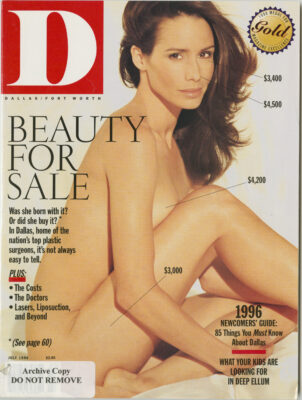we’ve been through a serious dry spell lately, but it’s nothing compared to the early 1950s, when we nearly ran out of water.
Most of our drinking water came from Lake Dallas in those days, and all seemed well until the owner of a boat rental company there reported his craft were running aground in what had been 40 feet of water, Much of our water supply, it turned out, was actually silt.
In the fall of 1952, the city hired Dr. Irving P. Krick, a cloud-seeder who had earned a reputation by predicting the weather for the D-Day invasion during World War H. Krick, a shameless self-promoter, bragged that one town had actually filed suit against him for causing a flood, but most Dallasites opposed the Krick contract as either foolhardy or sacrilegious.
In the spring of 1953, in a state of panic, the city council banned all lawn watering except on alternate Saturdays, later relenting when the town started to brown over, Krick had set up generators in the watershed area to fog clouds with silver iodide crystals, which were supposed to make it rain more than it would have otherwise. By May, he was claiming dramatic results-a 363 percent increase in die water supply-but we still didn’t have sufficient drinking water, so his contract was canceled. The water department concluded the most likely source to quench our thirst was the west fork of the Trinity River, an appalling thought to locals familiar with the river’s effluent content. Henry Graiser, assistant superintendent of the water department, dramatically downed a glass full of treated Trinity water at a special meeting of the city council, but onlookers were more aghast than encouraged. Graffiti began to appear in Fort Worth urging residents to “Flush-Dallas needs the water.”
City manager Elgin Crull claimed the state had approved the Trinity water, but detractors produced a copy of the so-called approval in which the term “final alternative” was used. Meanwhile, a rural practitioner of folk remedies offered to cure the shortage if the city would supply her with sufficient toads, but the water department decided to look to the Red River to save the city.
Krick was re-hired in the fall of ’53 with no noticeable results. By early ’54, the city was pumping Red River water through pipes and streams into Lake Dallas, but the water had a very high salt content. To lessen the briny taste, water from White Rock Lake was mixed into the supply, but cattails and duckweed in the lake made the water taste like weed soup. This being well before Perrier, a “lug-a-jug” program was set up at wells around the town for residents who could not abide the piped water.
By early 1955, Krick had been fired yet again and hired yet again, but the Red River was all that was keeping us alive. When the salt content began corroding hot water heaters, giving off a “rotten egg” smell, a crew from the water department was dispatched to Oklahoma to trace even,’ creek and stream flowing into the Red River. Among their discoveries was a fully operational salt mine.
By late summer of 1956, it began to rain in torrents, filling the Garza-Little Elm Reservoir to capacity. In subsequent publicity releases. Dr. Krick claimed most of die credit. but local churchgoers heaped their praises elsewhere.
Freaky Fourths
Do we really want an “old-fashioned” Fourth of July? You be the judge.
1862 Dallas Provost Marshall I ML John J. Good drafted local residents over the age of 16 to protect the town against any act of celebration found to be injurious to the cause of the Confederate States of America.
1898 At Fair Park, a man calling himself Professor Raymond leaped from an 85-foot tower, landing uninjured in a 3-foot tank of water. Before jumping, he loosed a chicken to descend upon the shrieking audience.
1899 In the first Independence Day celebration since the tumultuous victory in the war with Spain, a special program at Oak Cliff Park featured jingoistic orators and a demonstration of the Gatling gun.
1946 In an effort to boost Corny Dog sales at Fair Park, Neil and Carl Fletcher re-christened their treat the “Atomic K-9.”
1954 A special program at the Cotton Bowl featured fistfights, masked bandits, and a stagecoach robbery broken up by the Cisco Kid and Pancho.
1978 A Mr. and Miss Nude pageant was held at the D-FW Retreat on Highway 67; points were deducted for bathing suit marks. The celebration at Sandy Lake Park in Carrollton featured Minnie and Sue, mules trained to lumber off the high board into the swimming pool.
1983 The University Park City Council denied Harvey Gough (owner of Goff’s Hamburgers) permission to drive a 40-ton army tank in the Fourth of July parade because of the damage the tank had done to the pavement, curbs, and flower beds the previous year.
1985 The “Sea to Shining Sea” concert scheduled for Valley Ranch was canceled on July 3, leaving Dallas concessionaire Ed Campbell holding 100,000 ice cream bars and 450,000 pounds of ice.
Get our weekly recap
Brings new meaning to the phrase Sunday Funday. No spam, ever.
Related Articles

Arts & Entertainment
DIFF Preview: How the Death of Its Subject Caused a Dallas Documentary to Shift Gears
Michael Rowley’s Racing Mister Fahrenheit, about the late Dallas businessman Bobby Haas, will premiere during the eight-day Dallas International Film Festival.
By Todd Jorgenson

Commercial Real Estate
What’s Behind DFW’s Outpatient Building Squeeze?
High costs and high demand have tenants looking in increasingly creative places.
By Will Maddox

Hockey
What We Saw, What It Felt Like: Stars-Golden Knights, Game 2
It's time to start worrying.
By Sean Shapiro and David Castillo


